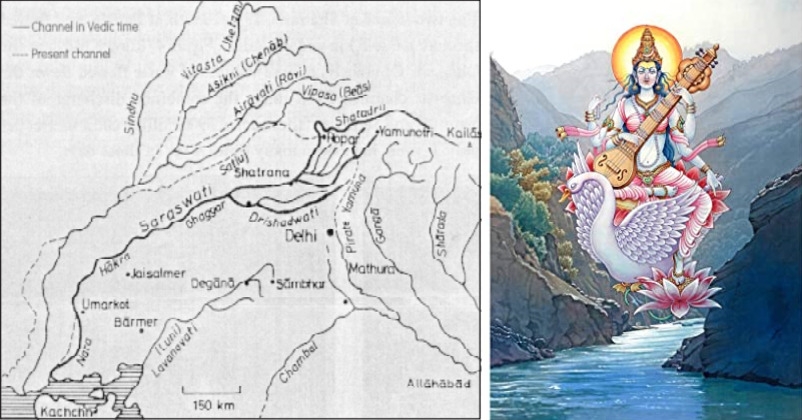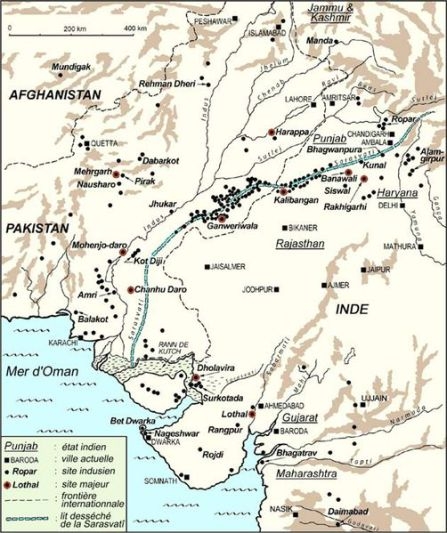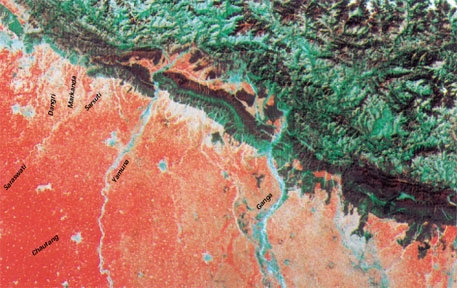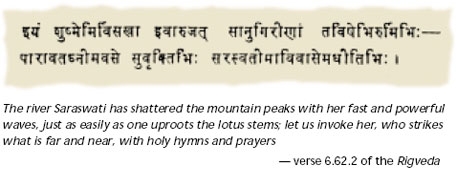Legend of Saraswati - the cradle of Vedic civilization of India
| 23-Sep-2020 |

Hindus of Kashmir valley claim themselves to be Saraswat Brahmins and trace their ancestry to the Saraswat Brahmins living along the course of the legendry river Saraswati, which formed the cradle of Vedic civilization of India. The Vedic civilization evolved over the entire north of India and its evolution was spread over centuries, and over an expanse of space which spread almost up to the Vindhya mountains in the south of India.
In Rig Veda, Saraswati is praised as the Mother among rivers; Ambitame, Naditame, Devitame, Saraswati. Its literal meaning is; “the greatest of goddesses, the greatest of mothers, the greatest of rivers”. Geological evidence has been found to suggest that the river Saraswati flowed down a north-westernly course, in northern India from “Himalaya” to the “Rann of Kutch”, in ancient times. It is believed to have dried up sometime between Vedic period and the time of Mahabharata. There is geological evidence to believe that the withdrawal of the waters of Yamuna and Satluj, which fed Saraswati, dried its waters. Saraswati was then the major river in northern India, independent of the Indus river system and the Ganges river system. After Saraswati vanished it became a legend.
In a revealing study of the history of the river Saraswati, Pandit MM Munshi, a geologist and researcher of great reputation, notes; "The quest for the lost river began about a hundred years back when a British engineer, CF Oldham, while riding across the broad dry bed of a small stream called Ghaggar visualized that a three kilometres wide river bed could not have been made by a puny seasonal stream like Ghaggar but must have been the course of a bigger river in the past". Munshi notes further," In the area between Indus and Ganges river systems or to be precise between the present courses of Yamuna and Satluj, a couple of seasonal dry channels flowing in westerly and south Westerly directions along very broad dry river beds namely Ghaggar and Sirsa met at Rasula near Patiala. Further downstream in Bhatnair near Bikaner in Rajasthan, they are joined by another dry seasonal channel called Chitrang which can be traced upstream eastwards upto Yamuna, and which is most likely the old abandoned course of Yamuna.
Tracing the course of Saraswati, Munshi notes, "Upstream of Bhatnair and downstream of Karnal, the Ghaggar is joined by another buried channel (dry river course), known at present as Wale, Sirhind or Wahind which can be traced upstream as far as Ropar, where Satluj emerges from the hills after traversing the Himalayas. It was the original course of the Satluj before it! changed its course to join the Bipasa (Beas) of the Indus system. A few more dried up channels north of Sirhind Channel, called Nahiwala have been traced upto Ropar. In Bikaner and further downstream for a length of about 150 km, the course of the channel is known as Sotur or Hakra, where it has attained a width of five to eight kilometres. At places, the course of river is still called Saraswati by local people. Further downstream the river course can be easily traced around Mirgarh, Dilawar in Bahawalpur and eastern Sind in Pakistan, southern Rajasthan into Rann of Kutch through Gujarat, quite distinct from the abandoned eastern channels of the Indus delta."

A map the Indus Valley civilization and Saraswati River Flow; Courtesy: Aashima Dogra
Munshi's research throws a new light on the Sind valley civilization and reveals a new direction, which the cultural evolution of the Sind valley and Harappan people assumed. His findings point out to a new civilization linkage which relates the Harappan culture to the people living along the course of the river Saraswati. Munshi notes," Along the course of this buried channel 175 pre and early historic archaeological sites have been excavated and confirmed by archaeologists, while only 85 of similar sites have been located along Indus in Pakistan. These sites have revealed dwelling sites potsherds and Mohanjodara and Harappan types of objects and artifacts. Recent excavations at Dholsvaria and other places have revealed figures of ocean-going vessels providing clues to the navigability of the dried upriver. It has been universally accepted that the earliest settlements in the Indian subcontinent and elsewhere flourished in major river valleys and not dry riverbeds, abandoned river course or uplands." Munshi doubts if pre-historic and early historic settlements, especially with a riverine culture, could have come up on the sides of the buried channels, unless a major river flowed along.

MM Munshi is a renowned researcher, remained a senior official of Geological Survey of India
The dried river bed of once mighty Saraswati; some historical and scientific evidence
Munshi notes that historical evidence is available to suggest that Bhawalpur in Pakistan and Bikaner in Rajasthan continued to be well watered at the time of Alexander's invasion of India in third century BC and up till ninth century AD. Todd writes in his major study, 'Annals of Rajasthan', that Hakra in Bikaner dried up in the eleventh century AD. Arab and Greek historical sources indicate that Satluj was not a river of Punjab till eleventh century AD, when it abandoned course and joined the river Beas. Beyond its confluence with Beas, Satluj is called Beas, though Satluj is the larger of the two rivers.

3D Map of the rivers flow in India, Courtesy- Down to Earth
There is enough scientific evidence, collected by latest scientific methods like satellite imagery, which corroborates the existence of a dried riverbed, along the course, which in ancient time was taken by the river Saraswati. Munshi notes, "The existence of 1600km long dry river bed/ buried channel/ paleo channel, varying in width from three to twelve kilometres, extending from Sirnoor Hills in Himachal Pradesh to Rann of Kutch, has been confirmed by the study of both black and white and coloured satellite images by experts, including Bimal Ghosh, Amal Karand and the scientists of Central Arid Zone Research Institute, PS Thakur of ISRO and others and that paleo-channels or dry river beds extending from the present tri-junction of Himachal Pradesh, the Punjab and Haryana, through Patiala, Karnal, Bhawalpur. Bikaner, south Rajasthan and Sind to Rann of Kutch in Gujarat, is the dried course of once mighty Saraswati river, quite distinct from the Indus river system."
Saraswati dried up due to the diversion of the river Yamuna to the river system of the Ganges, sometime in between the Vedic age and the time of the Mahabharta and the diversion of the water of Satluj to the river system of the Indus, sometime after the end of first millennium. Munshi notes; “Saraswati river was deprived of its water by diversion of Yamuna to Ganges system, sometimes between Vedic age and the epic of Mahabharata and Satluj to Indus system, much later due to neutectonic movements along the axis of Aravali range and was reduced to a dry river bed of several kilometres in width. Having lost its snow-fed sources the mighty Saraswati river disappeared and only legend remained in the folklore. The inhabitants from the banks migrated to far off places, like Kashmir, Western Punjab, Rajasthan, Gujarat, Maharashtra, Karnataka and even as far as Kerala, along the west coast some of whom still call themselves as Saraswat Brahmins or Saraswats. In mythology the prominence of Saraswati was taken over by Ganga."

There is enough ground to believe that the people of Kashmir formed a part of Saraswati civilization, because, it is hardly possible that the people who lived in Kashmir could not have established contact with the Saraswat culture, which spread over whole of the northern India. The human skeletons found at Burzahom in Kashmir point to a common ancestry of the people of northern India, who in the ancient times lived along the banks of the river Saraswati. The ritual structures of the Hindus of Kashmir have their source in the Vedic Kalpa Sutras and Grah Sutras. The entire system of the theological imperatives, the Hindus in Kashmir are bound to, have their origin in the Vedic religious precept of the Sanatan Dharma, the Sanskrit civilization of India evolved.
The conceptualization of temples as the abode of the Parmishwara, the Almighty God and the spiritual identity between man and his creator, realized in his communion with Paramishwara, in the Hindu temples, is strictly Vedic in content. The Hindu temples in Kashmir symbolize the unity of the Sanskrit civilization of India.
(These excerpts has been taken from the book "Kashmir: Hindu Shrines" written by C.L. Gadoo)